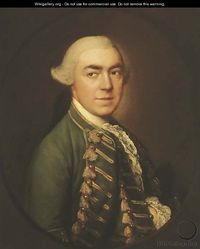Annotation:Nabob (The): Difference between revisions
No edit summary |
m (Text replacement - "garamond, serif" to "sans-serif") |
||
| (2 intermediate revisions by 2 users not shown) | |||
| Line 1: | Line 1: | ||
=='''Back to [[{{BASEPAGENAME}}]]'''== | =='''Back to [[{{BASEPAGENAME}}]]'''== | ||
---- | ---- | ||
<p><font face=" | <p><font face="sans-serif" size="4"> | ||
'''NABOB, THE.''' English, Jig. D Major. Standard tuning (fiddle). AABB. The melody was published by Charles and Samuel Thompson in their '''Compleat Collection, vol. 3''' (London, 1773), followed by Straight & Skillern in their '''Two Hundred and Four Favourite Country Dances, vol. 1''' (London, 1775). The word ''nabob'' derives from Hindi and Urdu words meaning a provincial governor, from the Mogul dynasty. Europeans, during the conquest and occupation of India, picked up the word which came to mean an important or wealthy person. | '''NABOB, THE.''' English, Jig. D Major. Standard tuning (fiddle). AABB. The melody was published by Charles and Samuel Thompson in their '''Compleat Collection, vol. 3''' (London, 1773), followed by Straight & Skillern in their '''Two Hundred and Four Favourite Country Dances, vol. 1''' (London, 1775). The word ''nabob'' derives from Hindi and Urdu words meaning a provincial governor, from the Mogul dynasty. Europeans, during the conquest and occupation of India, picked up the word which came to mean an important or wealthy person. | ||
< | </font></p> | ||
< | |||
[[File:foote.jpg|200px|thumb|left|Samuel Foote]] | [[File:foote.jpg|200px|thumb|left|Samuel Foote]] | ||
However, the title for the country dance tune probably refers to '''The Nabob,''' a three-act comedy by Cornwall-born playwright Samuel Foote (1720-1777) that premiered at the Haymarket in 1772 and at the Theatre-Royal in Dublin, in November, 1773. The story tells of a wealthy nabob, Sir Matthew Mite, who, upon his return home from India, attempts to purchase his way into the upper echelons of society. Foote played Sir | <p><font face="sans-serif" size="4"> | ||
However, the title for the country dance tune probably refers to '''The Nabob,''' a three-act comedy by Cornwall-born playwright Samuel Foote (1720-1777) that premiered at the Haymarket in 1772 and at the Theatre-Royal in Dublin, in November, 1773. The story tells of a wealthy nabob, Sir Matthew Mite, who, upon his return home from India, attempts to purchase his way into the upper echelons of society. Foote played Sir Matthew in the play, which, far from being a unique fancy, attacked in farce the well-known representative of a very influential though detested element in English society, the ''nouveau riche''. | |||
<br> | <br> | ||
<br> | <br> | ||
</font></p> | </font></p> | ||
<p><font face=" | <p><font face="sans-serif" size="4"> | ||
''Source for notated version'': | ''Source for notated version'': | ||
<br> | <br> | ||
<br> | <br> | ||
</font></p> | </font></p> | ||
<p><font face=" | <p><font face="sans-serif" size="4"> | ||
''Printed sources'': Thompson ('''Compleat Collection of 200 Favourite Country Dances, vol. 3'''), 1773; No. 177. | ''Printed sources'': Straight and Skillern ('''Two Hundred and Four Favourite Country Dances, vol. 1'''), c. 1775; No. 198, p. 99. Thompson ('''Compleat Collection of 200 Favourite Country Dances, vol. 3'''), 1773; No. 177. | ||
<br> | <br> | ||
<br> | <br> | ||
</font></p> | </font></p> | ||
<p><font face=" | <p><font face="sans-serif" size="4"> | ||
''Recorded sources'': <font color=teal></font> | ''Recorded sources'': <font color=teal></font> | ||
</font></p> | </font></p> | ||
<br> | <br> | ||
<br> | <br style="clear:both"/> | ||
---- | ---- | ||
=='''Back to [[{{BASEPAGENAME}}]]'''== | =='''Back to [[{{BASEPAGENAME}}]]'''== | ||
Latest revision as of 14:28, 6 May 2019
Back to Nabob (The)
NABOB, THE. English, Jig. D Major. Standard tuning (fiddle). AABB. The melody was published by Charles and Samuel Thompson in their Compleat Collection, vol. 3 (London, 1773), followed by Straight & Skillern in their Two Hundred and Four Favourite Country Dances, vol. 1 (London, 1775). The word nabob derives from Hindi and Urdu words meaning a provincial governor, from the Mogul dynasty. Europeans, during the conquest and occupation of India, picked up the word which came to mean an important or wealthy person.

However, the title for the country dance tune probably refers to The Nabob, a three-act comedy by Cornwall-born playwright Samuel Foote (1720-1777) that premiered at the Haymarket in 1772 and at the Theatre-Royal in Dublin, in November, 1773. The story tells of a wealthy nabob, Sir Matthew Mite, who, upon his return home from India, attempts to purchase his way into the upper echelons of society. Foote played Sir Matthew in the play, which, far from being a unique fancy, attacked in farce the well-known representative of a very influential though detested element in English society, the nouveau riche.
Source for notated version:
Printed sources: Straight and Skillern (Two Hundred and Four Favourite Country Dances, vol. 1), c. 1775; No. 198, p. 99. Thompson (Compleat Collection of 200 Favourite Country Dances, vol. 3), 1773; No. 177.
Recorded sources:
